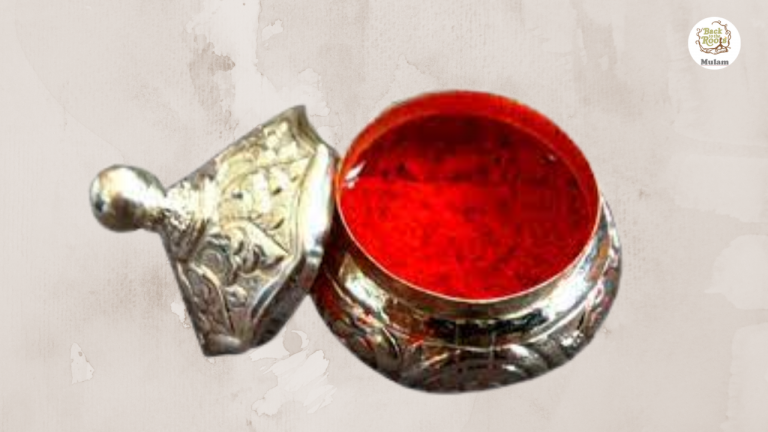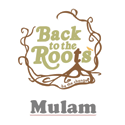Kuṅkuma (Vermilion Powder)

In India, culture and traditions abound. Sindoor, also known as kunkum, is an essential part of every married bride’s life because it is a part of our culture and traditions. It is also offered to God. When a married woman wears sindoor on her brow, it represents her marital status and inaccessibility.
It is simply a sign that you are not required to inform everyone. She also has other obligations. It is a socially acceptable method of identifying and distinguishing community members. In India, kunkum powder is used for social and religious purposes.
Preparation of organic kunkum
- Mix lime juice with alum and borax powder to make a solution.
- Pour this mixture over the turmeric powder and thoroughly combine to form a paste.
- When this mixture is dried in the sun, the turmeric turns red.
- Once completely dry, add a few drops of sesame or til oil to your palm and gently rub it together to moisten the mixture.
- Put this in a wooden or glass container.
- Use this when necessary.
The benefits of organic Kunkum
- Anna chakra is a place where it points right between the eyebrows on the forehead major nerves of the body meet. It is also known as the third eye. This point represents the awakening point as well as the position of the third eye. It relaxes us and helps us overcome anxiety.
- According to the principles of acupressure, this point relieves headaches.
- It strengthens the face muscles and keeps wrinkles at bay. The presence of supratrochlear nerves nourishes the skin and thereby helping the skin to look more supple
- Good for the eye muscles.
- It reduces the fine lines between the eyebrows. By massaging this point, you can keep the fine lines at bay, and increase blood flow.
- The Ajna chakra is prone to damage caused by anxiety and stress. Pressing this area daily will have a calming effect throughout the body.
- Those who suffer from insomnia will benefit greatly from this bindi area.
- On a more spiritual note, the color red is known to help the body retain positive energy, allowing us to remain strong, healthy, and positive throughout the day.
Significance
Every tradition has its own set of beliefs. In the Vaishnava and Swaminarayan traditions, the red color represents Lakshmi, and in the Swaminarayan tradition, it represents bhakta (devotee). Anyone who wears a tilak or kunkum will be protected by God for the rest of their lives. The colors red and yellow represent prosperity when combined.
Conclusion
By using organic kunkum, one can eliminate skin allergies, which are common in women who use commercial sindhoor. As a result, many women use chemical-based bindis or kunkum, which affects parted hair lines where kunkum is used by married women. All skin problems can be avoided by using organic kunkum. After learning about the benefits of kunkum, I believe that the majority of women will use it. Let us all follow our santhana dharma and keep our traditions and cultures alive by fading out.
In India, culture and traditions abound. Sindoor, also known as kunkum, is an essential part of every married bride’s life because it is a part of our culture and traditions. It is also offered to God. When a married woman wears sindoor on her brow, it represents her marital status and inaccessibility.
It is simply a sign that you are not required to inform everyone. She also has other obligations. It is a socially acceptable method of identifying and distinguishing community members. In India, kunkum powder is used for social and religious purposes.
Preparation of organic kunkum
- Mix lime juice with alum and borax powder to make a solution.
- Pour this mixture over the turmeric powder and thoroughly combine to form a paste.
- When this mixture is dried in the sun, the turmeric turns red.
- Once completely dry, add a few drops of sesame or til oil to your palm and gently rub it together to moisten the mixture.
- Put this in a wooden or glass container.
- Use this when necessary.
The benefits of organic kunkum
- Anna chakra is a place where it points right between the eyebrows on the forehead major nerves of the body meet. It is also known as the third eye. This point represents the awakening point as well as the position of the third eye. It relaxes us and helps us overcome anxiety.
- According to the principles of acupressure, this point relieves headaches.
- It strengthens the face muscles and keeps wrinkles at bay. The presence of supratrochlear nerves nourishes the skin and thereby helping the skin to look more supple
- Good for the eye muscles.
- It reduces the fine lines between the eyebrows. By massaging this point, you can keep the fine lines at bay, and increase blood flow.
- The Ajna chakra is prone to damage caused by anxiety and stress. Pressing this area daily will have a calming effect throughout the body.
- Those who suffer from insomnia will benefit greatly from this bindi area.
- On a more spiritual note, the color red is known to help the body retain positive energy, allowing us to remain strong, healthy, and positive throughout the day.
Significance
Every tradition has its own set of beliefs. In the Vaishnava and Swaminarayan traditions, the red color represents Lakshmi, and in the Swaminarayan tradition, it represents bhakta (devotee). Anyone who wears a tilak or kunkum will be protected by God for the rest of their lives. The colors red and yellow represent prosperity when combined.
Conclusion
By using organic kunkum, one can eliminate skin allergies, which are common in women who use commercial sindhoor. As a result, many women use chemical-based bindis or kunkum, which affects parted hair lines where kunkum is used by married women. All skin problems can be avoided by using organic kunkum. After learning about the benefits of kunkum, I believe that the majority of women will use it. Let us all follow our santhana dharma and keep our traditions and cultures alive by fading out.

